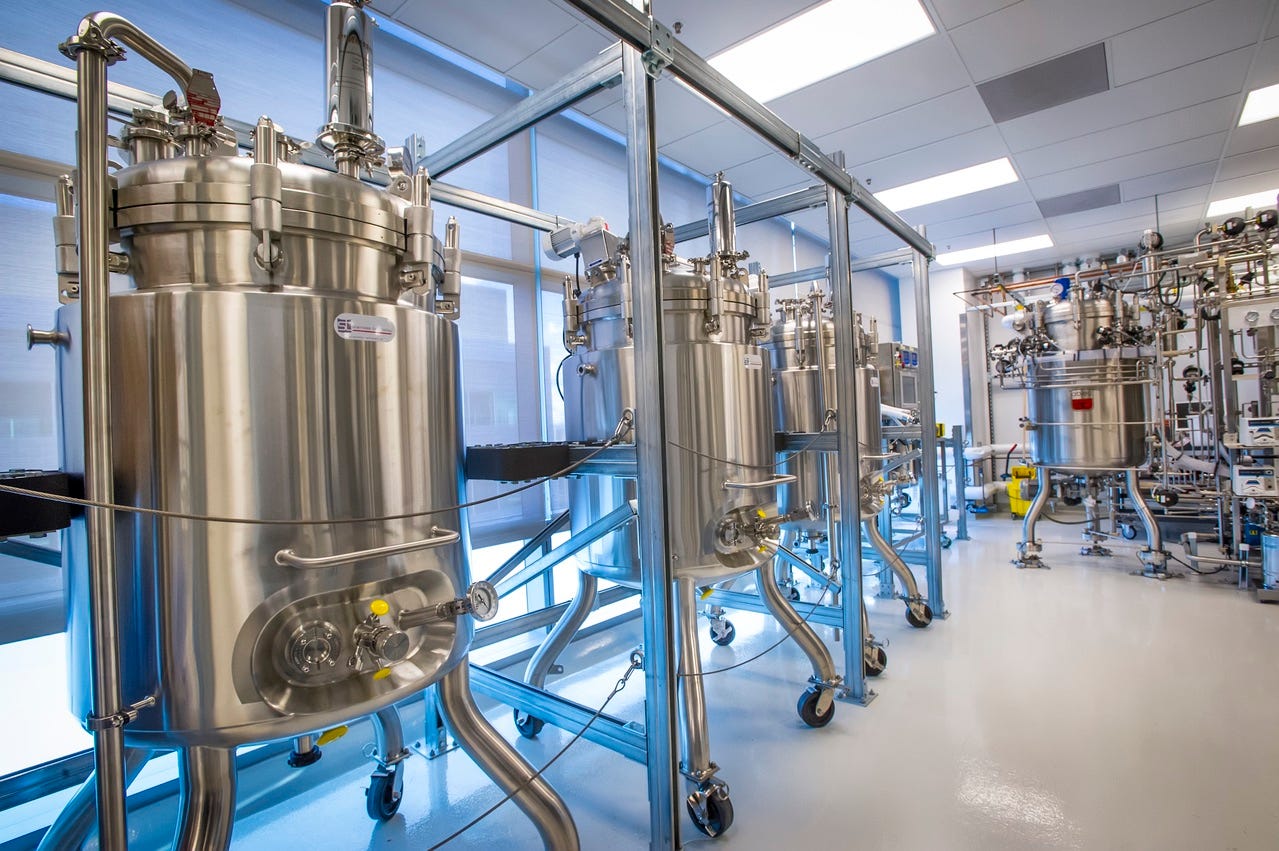Ferment all the things!
a short intro to all things biomanufacturing
Growing new things with biology can be sustainable, efficient, healthy, and even cheap. Using biotechnology to facilitate this process is one of the 20th Century’s greatest achievements and will be key to living sustainably in a warming world. While I firmly believe that we must begin engineering the living world around us, to survive, in the meantime we must engineer living systems in controlled environments.
The synthetic biology revolution is a biomanufacturing revolution. You can call it fermentation, biosynthesis, bioproduction, or bioconversion. At its core, it’s growing cells and processing them to produce a product of interest. Let’s walk through the different ways this is done today and some big problems we still need to solve.
Biomanufacturing in mammalian cells
Biotech of the ‘80s and ‘90s was powered by engineered mammalian cells producing revolutionary new biologic drugs (mostly antibodies) at companies like Genentech and Amgen. These are commonly highly regulated, complex, and expensive production systems used for very high-value products. Worth a side note that lab grown meat falls in this category.
Classic fermentation
This is the fermentation we know and love: brewing beer and making kombucha. In this case, microbes consume sugar or other carbon sources to produce an end product, such as Ethanol in the case of biofuels, heme protein like Impossible Foods, or additives like citric acid.
The end product may also be the whole microbe itself, in the case of “single cell protein” used for aquafeed, or probiotics, which are beneficial microbes you might find in yogurt or dietary supplements.
Photosynthetic biomanufacturing
In this case, the sun + atmospheric CO₂ act as “feedstock.” Algae is the big player, including cyanobacteria like Spirulina (Spira). Feedstocks are plentiful and widespread, but you must grow these organisms in photobioreactors or open pond systems. We’re also seeing companies using whole plants as bioreactors (Tiamat, Nobell Foods).
Syngas and C1 fermentation
There are microbes that can use carbon rich gasses as their carbon source (rather than sugar). Syngas uses a mixture of H, CO, and CO₂ as feedstock for microbes - C1 fermentation uses CO₂, CO, or CH₄ (methane). Today these gas fermentation techniques are used for producing Ethanol, Butanol, jet fuel (Lanzajet), and even single cell protein (Novonutrients). Using CO₂ as feedstock sounds great (these fermentation processes are potentially carbon negative), but gas fermentation requires expensive infrastructure and is generally inefficient.
Enzymatic transformation and biocatalysis
Rather than relying on enzymatic pathways within cells, why not isolate enzymes and use them to transform one substance into another? A feedstock is processed using various enzymes (natural catalysts) to produce the product of interest. The enzymes are made in living cells, but are then isolated and used “cell free.” Solugen is transforming carbon sources into chemicals and Sweegen turns Stevia into a better sweetener.
Electrofermentation
Electroactive bacteria can exchange electrons and energy with their environments, effectively allowing electric currents in the fermentation medium to drive metabolism. Electricity can also be used to produce H from water which is then metabolized by microbes called hydrogenotrophs (Solar Foods).
Solid state fermentation
To wrap up this lengthy list, I want to touch on solid state fermentation. Rather than liquid phase microbes swirling in a tank, here organisms grow on a solid medium. It commonly uses fungal species that are able to convert solid biomass into higher value products - some turn waste biomass into packaging or textiles (Mycoworks). Others are exploring opportunities in food (Sincarne).
That’s a lot of variations, and we’re going to need the whole rainbow to successfully decarbonize our economy. There will not be one type of biomanufacturing to rule them all.
The biggest challenge we are now facing is economically scaling these processes. Making stuff at bench scale can usually be done fairly easily, but a huge amount of optimization is needed to economically reach commercialization: you need high titers and predictable growth rates. If you can make it at 1L, that means little for making it at 100L or 100,000L. Smaller batches might be OK for high value products, but much larger scale is needed for food, chemicals, and lower value commodity products.
Additionally, downstream processing (purification) is most of the cost of making a bioproduct. Even if your microbe grows great, you’ve got to get through DSP.
Lastly, we need more people building large scale biomanufacturing infrastructure in this country. There is a dire shortage of capacity for sale or rent, of capital willing to put steel in the ground, and an even greater shortage of talented people to build and manage this infrastructure.
NOTE: I’m sure I missed some other interesting biomanufacturing techniques, so feel free to get in touch and let me know.


This is one of the clearest overviews I’ve read of the various fermentation techniques companies are utilizing. I work in the plant-based space, which has begun to overlap with the cultured meat and precision fermentation spaces. Getting a better understanding of these things helps me visualize where the movement is and where it’s going. Thanks for writing this!